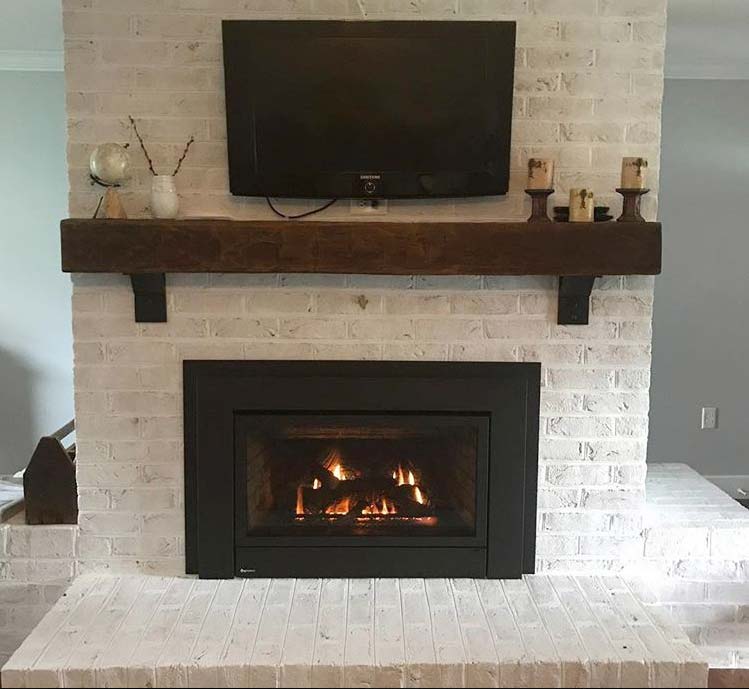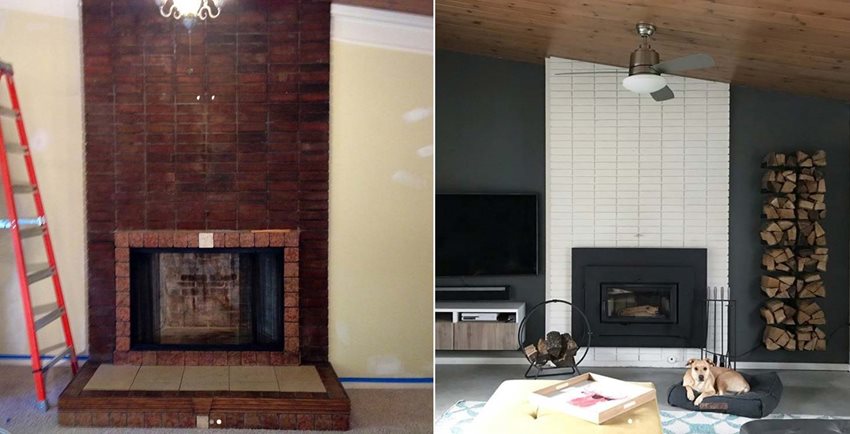Upgrading your fireplace insert can boost your home’s heating efficiency, safety, and visual appeal. Whether you already have an old wood-burning insert or want to upgrade to a more convenient gas or electric one, modern fireplace inserts have various advantages. Newer types offer higher heat output, cleaner functioning, and advanced features such as remote controls and programmable thermostats. This tutorial covers different components of improving your fireplace insert, from selecting the appropriate type to correct installation and upkeep.
Types of Fireplace Inserts
Fireplace inserts are available in three different fuel types: wood, gas, and electric. Wood-burning inserts provide a traditional experience with realistic flames and high heat output. Modern wood inserts are extremely efficient, with EPA-certified versions emitting little pollutants. However, they must be cleaned on a regular basis and have a chimney to provide sufficient ventilation.
Gas fireplace inserts offer rapid heat with the stroke of a button. They operate on natural gas or propane and do not require wood storage or ash removal. Many gas inserts include realistic log sets and adjustable flame settings. Direct vent systems, which use outside air, are a safer and more efficient alternative to traditional fireplaces.
Electric fireplace inserts are the most straightforward to install and maintain. They connect into regular outlets and do not require ventilation, making them appropriate for any space. While they may not produce actual flames, contemporary LED technology produces amazingly lifelike fire effects. Electric inserts frequently incorporate heating elements with adjustable thermostats, making them ideal for supplemental warmth.
Measuring for Proper Fit
When buying a new fireplace insert, precise measurements are essential. Start by measuring the width, height, and depth of your current fireplace opening. Most inserts require at least 1 inch of room on all sides to ensure proper installation and airflow. Check the manufacturer’s specifications to ensure they are compatible with your fireplace measurements.
When selecting an insert, consider the size of the space to be heated. Inserts are graded according on BTU production, with larger spaces requiring greater BTU ratings. A unit that is too tiny will not heat properly, and an enormous insert may overheat the area. Measure the room’s square footage and check with professionals to establish the proper heating capacity.
If you’re building a wood or gas insert, make sure you measure the flue or chimney opening first. The new unit must be correctly connected to your existing ventilation system. Some inserts require specified liner sizes or adapter kits to install properly. Taking precise measurements up early eliminates costly mistakes and assures peak performance.

Efficiency and Heating Performance
Modern fireplace inserts are substantially more efficient than classic open fireplaces. Wood-burning inserts can attain efficiency ratings of 70% or greater, which means that more heat remains in your home rather than going up the chimney. Look for EPA-certified wood inserts that meet stringent emissions requirements for cleaner burning.
Gas inserts typically achieve 70% to 85% efficiency, with some high-end ones exceeding 90%. Many have variable flame settings, which allow you to alter the heat output while keeping the ambiance of a fire. Direct vent gas inserts are extremely efficient since they draw combustion air from the outside rather than heating the interior air.
Electric inserts convert virtually all of their energy into heat, making them ideal for supplemental heating rather than primary heat sources. Some versions have zone heating capabilities, which allows you to heat only occupied rooms. When calculating long-term operational expenses, take into account the cost of various fuel types in your area.
Installation Considerations
Professional installation is suggested for most fireplace insert improvements, particularly for wood and gas versions. Certified technicians guarantee adequate ventilation, gas line connections, and clearances from combustible items. Improper installation can result in fire or carbon monoxide concerns. Many manufacturers demand expert installation to ensure warranty coverage.
To increase ventilation and minimize creosote buildup, wood insert installations frequently require a stainless steel chimney liner. Gas inserts may need the installation of new gas lines or the inspection of existing lines for leakage. Electric inserts are frequently the simplest to install, requiring only a regular outlet and, in certain cases, a dedicated circuit for higher wattage models.
Local building rules may specify installation requirements for fireplace inserts. Permits are commonly required, especially for gas installations. Check with your municipality before starting the project. Proper installation not only ensures safety, but it also improves the insert’s efficiency and performance.
Design and Aesthetic Options
Today’s fireplace inserts offer a wide range of design options to complement your home’s decor. Wood inserts come in a variety of door types, including traditional cast iron and contemporary glass fronts. Many incorporate air wash systems, which keep the glass clean and improve flame visibility.
Gas inserts are available with genuine log sets, stone, and modern media such as glass beads or crushed stone. Some types provide interchangeable media options, allowing you to vary the look seasonally. Trim kits are available in a variety of finishes, including black, brass, and brushed nickel, to complement your fireplace surround.
Electric inserts offer the greatest design versatility, with options ranging from classic mantel packages to ultra compact wall-mounted units. Many have changeable flame colors and brightness settings. Some high-end models have realistic ember beds and sound effects to enhance the burning experience.
Maintenance and Care
Regular maintenance keeps your fireplace insert operating safely and efficiently. Wood inserts demand the most maintenance, including weekly ash clearance and an annual chimney cleaning. To maintain adequate seals, check gaskets around doors and glass on a regular basis and replace them as they wear.
Gas inserts require annual expert inspections to ensure that the burners, vents, and safety systems are functioning properly. Keep the glass clean using certified cleansers to ensure that the flames remain visible. Carbon monoxide detectors should be tested on a monthly basis while utilizing gas equipment.
Electric inserts require the least amount of maintenance, however they do benefit from an occasional dusting of internal components. Examine the cords and plugs for damage, and ensure adequate airflow around the unit. To maintain the best appearance of the flame effect components, follow the manufacturer’s cleaning instructions.
How much will it cost to upgrade a fireplace insert?
Fireplace insert prices vary greatly depending on their style and characteristics. Basic electric models start about $500, while mid-range gas inserts cost between $2,000 and $3,500, including installation. High-efficiency wood inserts cost between $3,000 and $5,000 with professional installation. Chimney liners, gas line installation, and electrical work are all potential additional costs. While the initial investment can be high, increased efficiency frequently results in long-term savings on heating expenditures. Many homeowners believe the investment is justified for both comfort and property value.
Can I install the fireplace insert myself?
While electric inserts are frequently DIY-friendly, wood and gas inserts typically require professional installation. Gas line installation and venting require specialist knowledge to assure safety and compliance with local codes. Wood insert installations usually necessitate chimney liner work, which is best left to qualified professionals. Even with electric models, it is best to see a trained electrician if you want new wiring. Improper installation might result in fire dangers and violate warranties. Most manufacturers’ warranties for gas and wood units need professional installation.
Will a new fireplace insert actually save heating costs?
Yes, upgrading to a contemporary, efficient fireplace insert can greatly cut heating costs. Traditional open fireplaces are roughly 10% efficient, whereas modern inserts range from 70% to nearly 100% efficiency. This means that more heat remains in your home rather than going up the chimney. Many homeowners report significant savings in their heating expenditures after installing an efficient insert. The actual savings vary according on your climate, fuel expenses, and how frequently you use the insert. Some utility companies provide rebates for installing high-efficiency fireplace inserts, thereby increasing the return on investment.
How frequently should I have my gas fireplace insert serviced?
Gas fireplace inserts should be professionally maintained on a yearly basis, ideally before the heating season begins. A professional technician will clean the burners, check for gas leaks, inspect vents, and test the safety systems. Between expert visits, maintain the glass clean and ensure that vents are not impeded. If you detect any problems, such as strange scents, difficulty lighting, or soot buildup, schedule service right away. Regular maintenance assures safe operation, efficiency, and increases the unit’s longevity. Many manufacturers need annual servicing to maintain warranty validity.
What is the distinction between a fireplace insert and a freestanding stove?
Fireplace inserts are intended to fit into existing masonry fireplaces, whereas freestanding stoves stand alone in a room. Inserts use the existing fireplace structure and frequently include built-in surrounds for a finished effect. Stoves generally emit heat from all directions and may necessitate particular floor protection. Both can be quite efficient, but inserts typically have a more integrated appearance. Stoves often produce more radiant heat, whereas inserts may have fans to improve heat circulation. The decision is based on your space, existing fireplace, and heating requirements.
Can I change my wood-burning insert to gas?
Yes, many wood-burning fireplace inserts may be changed to gas, but the process requires professional installation. The method entails removing the wood-burning components and installing a gas burner system tailored to your individual insert type. A qualified technician must properly connect the gas line and make any necessary venting changes. Not all wood inserts have certified gas conversion kits, so check with the manufacturer first. Converting to gas eliminates the need for wood and makes operation more easy, but you will miss the true wood-fired experience. Some homeowners prefer to install a whole new gas insert rather than converting an older wood item.
Fireplace Makeover Ideas Before and After Regency
Fireplace Update Before Afters
Related Posts:








